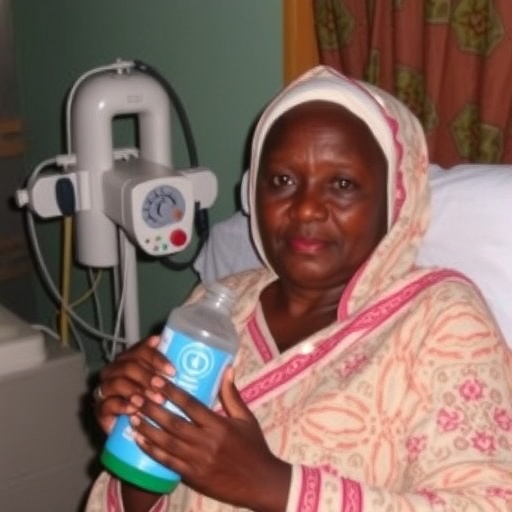In the rapidly evolving landscape of healthcare, the critical role of oxygen therapy has often been overlooked, especially in resource-limited settings. A recent systematic review and meta-analysis conducted by researchers Geta Hardido, T., Atinafu, B., Israel, E., and colleagues sheds light on the practices and knowledge surrounding oxygen therapy among healthcare providers across East African countries. This comprehensive study aims to explore the awareness, implementation, and challenges of oxygen therapy, revealing significant gaps that could hinder optimal healthcare delivery in these regions.
Oxygen therapy is an essential component of modern medicine, pivotal in the treatment of various medical conditions such as chronic obstructive pulmonary disease, pneumonia, and during critical care scenarios. Despite its importance, the knowledge and practices regarding oxygen therapy among healthcare providers in East Africa have remained largely uninvestigated. This systematic review draws attention to the necessity of understanding how well healthcare professionals are equipped to manage oxygen delivery effectively in their settings.
The systematic review encompassed numerous studies, highlighting the diverse levels of training and knowledge among healthcare providers concerning oxygen therapy. It was found that many healthcare workers demonstrated a basic understanding of when to administer oxygen, primarily in emergency situations. However, the knowledge of the correct flow rates, delivery methods, and the assessment of a patient’s need for oxygen was notably deficient in several reported cases. This alarming revelation underlines the critical need for enhanced training programs tailored to the unique challenges faced by healthcare providers in East Africa.
In many East African nations, including Ethiopia, Kenya, and Uganda, healthcare systems often grapple with limited resources and inadequate infrastructure. In such environments, ensuring that healthcare providers have access to training and updated knowledge about oxygen therapy is not just beneficial but necessary. The analysis indicated that insufficient training often leads to suboptimal patient outcomes, with lifesaving interventions being delayed or implemented incorrectly due to a lack of confidence and skills among providers.
Moreover, the findings of the review highlighted the systemic barriers that limit the accessibility of oxygen therapy in many East African healthcare facilities. The study revealed that procedural guidelines around oxygen therapy vary significantly from one facility to another, leading to inconsistencies in practice even among experienced healthcare providers. This inconsistency can exacerbate health disparities in regions where access to treatment is already challenged, further emphasizing the urgent need for standardized protocols and guidelines for oxygen therapy.
Equally significant is the perception of oxygen therapy among healthcare practitioners. Many believe that oxygen is a resource that is often misused or overprescribed, which can lead to compartmentalization in treatment approaches. This notion can hinder the proactive identification of patients who would benefit from timely oxygen administration, creating a critical gap in the continuum of care for various respiratory conditions.
The study ultimately calls for a concerted effort to enhance educational strategies focusing specifically on the appropriate use of oxygen therapy. Continuous professional development, workshops, and refresher courses could play a pivotal role in empowering healthcare providers with the necessary knowledge and confidence to deliver oxygen therapy effectively. Such initiatives could lead to the establishment of a culture that embraces evidence-based practices and enhances overall patient care quality.
In addition, the authors advocate for policy changes at higher administrative levels to ensure that healthcare systems prioritize oxygen therapy as a key component of healthcare delivery. This may involve increased investment in oxygen supply chains, implementation of monitoring systems, and regular assessments of healthcare providers’ skills and knowledge regarding oxygen therapy. Addressing these systemic issues not only requires collaboration among healthcare professionals but also robust engagement with policymakers to influence positive change.
Collaboration among healthcare providers across regions can lead to improved knowledge sharing and practices regarding oxygen therapy. Networking and partnerships among facilities, as well as regional educational initiatives, can pave the way for a more unified approach to treating respiratory illnesses in East Africa. Collective learning experiences can foster stronger relationships and create a more cohesive healthcare community focused on the common goal of enhancing patient care.
Establishing a focal point for resources and training related to oxygen therapy within medical institutions is equally essential. Such centers could be dedicated to research, training, and the development of best-practice guidelines. These centers would serve as hubs for educational outreach, enabling healthcare workers to access updated information and resources that align with global standards.
As East African countries continue making strides toward improved healthcare, the importance of addressing the gaps in oxygen therapy practices cannot be overstated. The systematic review serves as a wake-up call, emphasizing that without adequate knowledge and training for healthcare providers, the full potential of oxygen therapy will remain untapped. More importantly, it represents an opportunity for stakeholders at all levels to innovate and enhance healthcare services in a way that is both sustainable and effective.
In conclusion, the findings of this systematic review and meta-analysis illuminate critical challenges and opportunities for advancing the understanding and application of oxygen therapy in East Africa. Addressing the knowledge gaps among healthcare providers could lead to significantly improved patient outcomes, making it essential for the healthcare community to take immediate, concerted action.
As global health continues to evolve, it is critical to foster environments that prioritize continuous learning, adequate training, and health equity. By embracing these principles, the healthcare systems in East Africa will be better positioned to meet the increasing demands of their populations and provide effective interventions through oxygen therapy and other essential healthcare services.
Subject of Research: Knowledge and practices of oxygen therapy among healthcare providers in East African countries.
Article Title: Healthcare providers’ practice and knowledge towards oxygen therapy in East African countries: a systematic review and meta-analysis.
Article References:
Geta Hardido, T., Atinafu, B., Israel, E. et al. Healthcare providers’ practice and knowledge towards oxygen therapy in East African countries: a systematic review and meta-analysis.
BMC Health Serv Res (2025). https://doi.org/10.1186/s12913-025-13797-0
Image Credits: AI Generated
DOI: 10.1186/s12913-025-13797-0
Keywords: Oxygen therapy, healthcare providers, East Africa, knowledge gaps, systematic review, patient outcomes, healthcare training.




